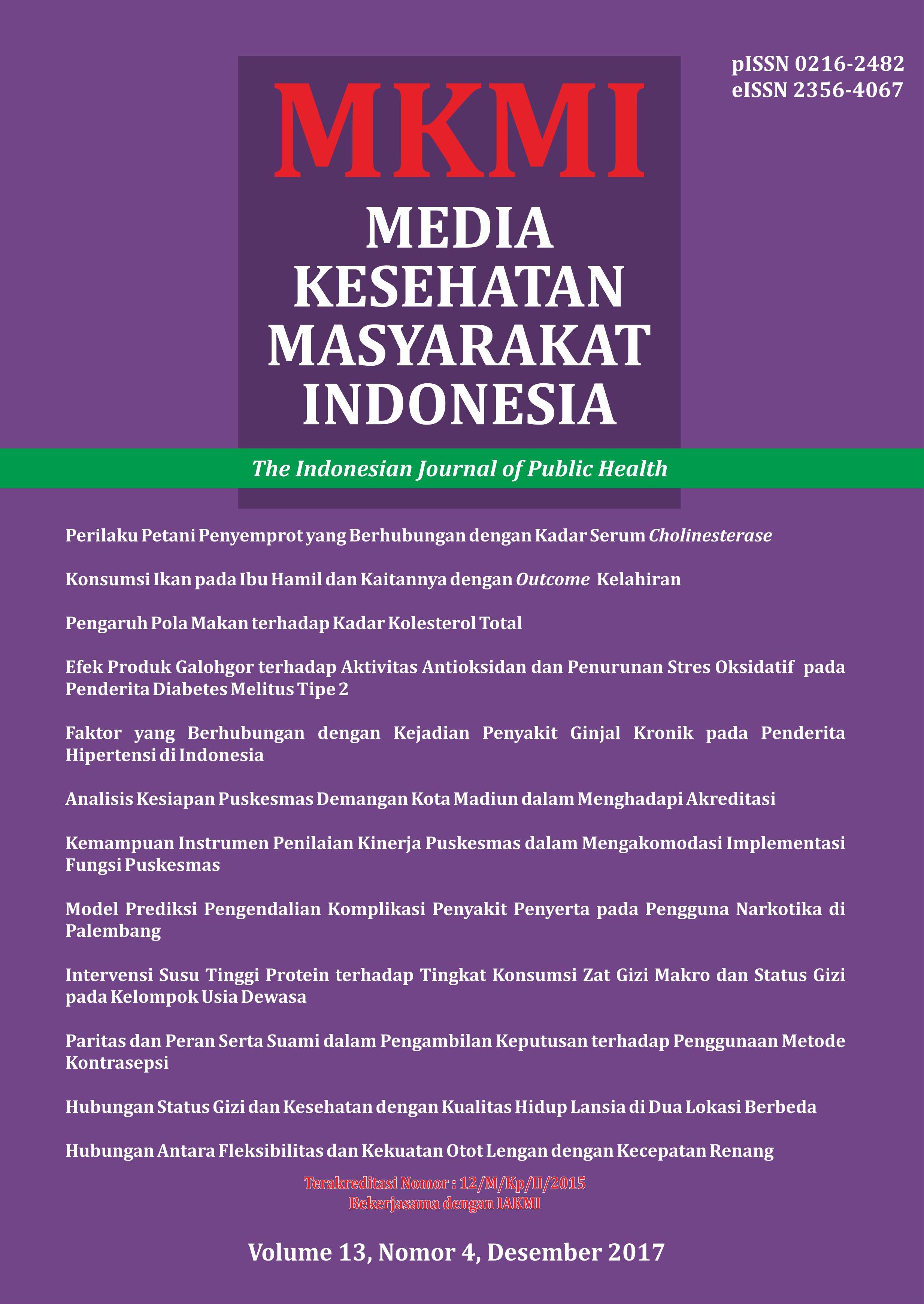MODEL PREDIKSI PENGENDALIAN KOMPLIKASI PENYAKIT PENYERTA PADA PENGGUNA NARKOTIKA DI PALEMBANG
Abstract
References
BNN. Jurnal Data P4GN. Pencegahan, Pemberantasan Penyalahgunaan dan Peredaran Gelap Narkoba. Jakarta; 2012.
BNNP. Data Penyalahguna Narkotika. Badan Narkotika Nasional Provinsi Sumatera Selatan; 2014.
Mathers BM, Degenhardt L, Phillips B, Wiessing L, Hickman M, Strathdee SA, et al. Global Epidemiology of Injecting Drug Use and HIV among People Who Inject Drugs: A Systematic Review. The Lancet.372(9651):1733-45.
Bluthenthal RN, Wenger L, Chu D, Lorvick J, Quinn B, Thing JP, et al. Factors Associated with Being Asked to Initiate Someone into Injection Drug Use. Drug and Alcohol Dependence. 2015;149:252-8.
MJ. A. Prevention of Spread of Hepatitis C. Hepatology 2002;36(5):S93 S98 [PubMed: 12407581].
Dore GJ LM, MacDonald M, Kaldor JM . Epidemiology of Hepatitis C Virus Infection in Australia. J Clin Virol 2003;26(2):171–184 [PubMed: 12600649].
H. H. Hepatitis C Virus Transmission Dynamics in Injection Drug Users. Subst Use Misuse 1998;33:1197–1212 [PubMed: 9596383.
Donovan D MM, Cisler RA, Longabaugh R, Zweben A. Quality of Life as An Outcome Measure in Alcoholism Treatment Research. J Stud Alcohol. 2005;(Suppl):119–139 Discussion 92-3.
Brindis CD, & Theidon, K. S. The Role of Case Management in Substance Abuse Treatment Services for Women and Their Children. Journal of Psychoactive Drugs. 1997;29:79–88.
McLellan AT, Lewis, D. C., O’Brien, C. P., & Kleber, H. D. Drug Dependence, A Chronic Medicalillness Implications for Treatment, Insurance, and Outcomes Evaluation. Journal of the American Medical Association. 2000;284:1689–1695.
Degenhardt L, Bucello C, Mathers B, Briegleb C, Ali H, Hickman M, et al. Mortality Among Regular or Dependent Users of Heroin and Other Opioids: A Systematic Review and Meta-Analysis Of Cohort Studies. Addiction. 2011;106(1):32-51.
Wall M, Schmidt E, Sarang A, Atun R, Renton A. Sex, Drugs And Economic Behaviour in Russia: A study of Socio-Economic Characteristics of High Risk Populations. International Journal of Drug Policy.22(2):133-9.
Horyniak D, Higgs P, Jenkinson R, Degenhardt L, Stoové M, Kerr T, et al. Establishing The Melbourne Injecting Drug User Cohort Study (MIX): Rationale, Methods, and Baseline and Twelve-Month Follow-up Results. Harm Reduction Journal. 2013;10:11.
Lambers FAE, Stolte IG, van den Berg CHSB, Coutinho RA, Prins M. Harm Reduction Intensity Its Role in HAART Adherence amongst Drug Users in Amsterdam. International Journal of Drug Policy. 2011;22(3):210-8.
Damayanti R. Peran Biopsikososial terhadap Perilaku Berisiko Tertular HIV pada Remaja SLTA di DKI (Disertasi). Fakultas Kesehatan Masyarakat: Indonesia; 2007.
Rodkjaer L, Chesney MA, Lomborg K, Ostergaard L, Laursen T, Sodemann M. HIV Infected Individuals with High Coping Self Efficacy are Less likely to Report Depressive Symptoms: A Cross-Sectional Study from Denmark. International Journal of Infectious Diseases. 2014;22(0):67-72.
Ma N, Liu Y, Fu XM, Li N, Wang CX, Zhang H, et al. Abnormal Brain Default-Mode Network Functional Connectivity in Drug Addicts. PloS one. 2011;6(1):e16560.
Wang X, Li B, Zhou X, Liao Y, Tang J, Liu T, et al. Changes in Brain Gray Matter in Abstinent Heroin Addicts. Drug and Alcohol Dependence. 2012;126(3):304-8.
Nwagu EN. Alcohol and Drug Usage; and Adolescents’ Sexual Behaviour in Nigeria. Health Promotion International. 2015.
Baldwin P, Shrestha R, Potrepka J, Copenhaver M. The Age of Initiation of Drug Use and Sexual Behavior May Influence Subsequent HIV Risk Behavior: A Systematic Review. ISRN AIDS. 2013;2013:17.
Sitorus RJ, Natalia M. Perilaku Seksual Berisiko Pengguna Narkotika. Kesmas : National Public Health Journal. 2015;9(4):348-52.
Kemenkes. Strategi Promosi Pencegahan Penyalahgunaan Napza di Indonesia. Jakarta: Departemen Kesehatan ; 2001.
Hasin D, Liu X, Nunes E, McCloud S, Samet S, Endicott J. Efects of Major Depression on Remission and Relapse of Substance Dependence. Archives of General Psychiatry. 2002;59(4):375-80.
Brown S, Jun MK, Min MO, Tracy EM. Impact of Dual Disorders, Trauma, and Social Support on Quality of Life Among Women in Treatment for Substance Dependence. Journal of Dual Diagnosis. 2013;9(1):61-71.
Smyth B, Hoffman V, Fan J, Hser Y-I. Years of Potential Life Lost among Heroin Addicts 33 Years after Treatment. Preventive Medicine. 2007;44(4):369-74.
McKellar J, Ilgen M, Moos BS, Moos R. Predictors of Changes in Alcohol Related Self-Efficacy Over 16 Years. Journal of Substance Abuse Treatment. 2008;35(2):148-55.
Authors
Authors retain copyright and grant the journal right of first publication with the work simultaneously licensed under a Creative Commons Atribusi-NonKomersial-BerbagiSerupa 4.0 Internasional License that allows others to share the work with an acknowledgement of the work's authorship and initial publication in this journal.
Copyright encompasses rights to reproduce and deliver the article in all form and media, including reprints, photographs, microfilms and any other similar reproductions, as well as translations. The reproduction of any part of this journal, its storage in databases and its transmission by any form or media, such as electronic, electrostatic and mechanical copies, photocopies, recordings, magnetic media, etc.
All articles published Open Access are free for everyone to read and download. Under the CC-BY-NC-SA license, authors retain ownership of the copyright for their article, but authors grant others permission to use the content of publications in Media Kesehatan Masyarakat Indonesia Universitas Hasanuddin in whole or in part provided that the original work is properly cited. Users (redistributors) of Media Kesehatan Masyarakat Indonesia Universitas Hasanuddin are required to cite the original source, including the author's names, Media Kesehatan Masyarakat Indonesia Universitas Hasanuddin as the initial source of publication, year of publication, and volume number.
Media Kesehatan Masyarakat Indonesia Universitas Hasanuddin is licensed under Creative Commons Atribusi-NonKomersial-BerbagiSerupa 4.0 Internasional.


